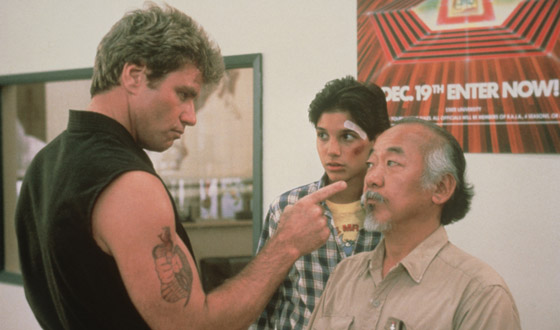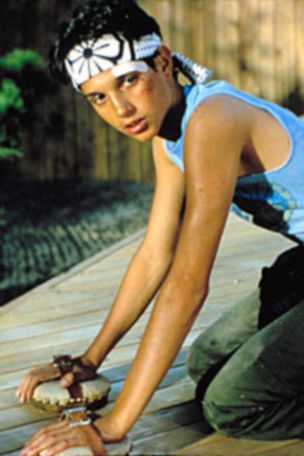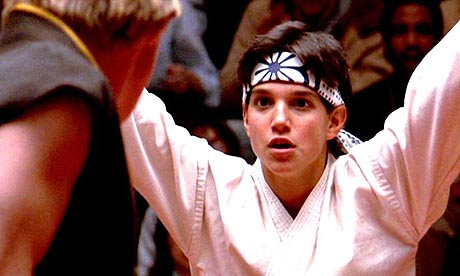Miyagi: Now, ready?
Daniel: Yeah, I guess so.
Miyagi: [sighs] Daniel-san, must talk.
[they both kneel]
Miyagi: Walk on road, hm? Walk left side, safe. Walk right side, safe. Walk middle, sooner or later
[makes squish gesture]
Miyagi: get squish just like grape. Here, karate, same thing. Either you karate do “yes” or karate do “no.” You karate do “guess so,”
[makes squish gesture]
Miyagi: just like grape. Understand?
Daniel: Yeah, I understand.
Miyagi: Now, ready?
Daniel: Yeah, I’m ready.
I must have watched Karate Kid ten or twelve times before the age of 10. I was besotted by the boy-done-good, underdog-triumphs-over-high-school-bully-hegemony vibe in the 1984 classic starring Ralph Macchio and Noriyuki ‘Pat’ Morita. For those too young to appreciate the golden age of 80s teen films, it told the story of Daniel Larusso, a troubled latchkey kid from a single parent family who moves to a new neighbourhood. He is harangued by the cackling cool kids at his new high school who are all, it turns out, training in Karate at the same local dojo.
One evening, having battled to escape his pursuers (on BMXs, of course, it being the eighties) he runs into janitor Mr Miyagi, a lugubrious, diminutive, Yoda-like Japanese man who speaks in pidgin-English aphorisms and has a Bonsai tree fetish. To cut a long story short: Mr Miyagi turns out to be a karate badman and puts Daniel through a crash masterclass that sees him slogging his way to the finals of the local karate tournament, kicking his arch nemesis’s ass with an ostentatious swan-kick, and, of course, getting the girl in the process. The end.
I’m not sure the film would stand the test of time. Even as a mere slip of a boy I remember finding Macchio’s character annoying, but fawned at the crying-in-the-rain lost love eighties scenes when things go awry with his beloved (Elizabeth Shue - be still my beating eight-year-old heart!) to a crushing soundtrack of Bananarama’s Cruel Summer: although in summary I imagine it to be mawkish, outdated and over-acted.
But even to my jaded, overenlightened, thirtysomething cynic’s mind, there’s a lot of Zen wisdom in the film, particularly from Miyagi. As well as a sentiment to the film that makes it a stayer. And, in all serious seriousness, one particular scene has real resonance for me, especially in the context of Live Magazine…

Miyagi and the evil sensei
In the film, Miyagi puts Larusso into an informal Karate apprenticeship, having made an audacious pact with the pugnacious lantern-jawed dojomaster (who is training up all of Daniel’s nasty little tormentors as vicious facsimiles of his own troubled Vietnam-vet soul) that they will leave him alone if Daniel wins the forthcoming karate tournament. This apprenticeship involves Daniel volunteering his time to Mr Miyagi during his school holidays, and turning up every day at his Japanese-style paper house to perform a series of tasks. At the beginning of each day, Miyagi sets the task and then buggers off.
First day: paint the house with horizontal brushstrokes - LEFT!/ RIGHT!/ LEFT!/ RIGHT!
Second day: paint the fence - UP!/ DOWN!/ UP!/ DOWN!
Third day: Wax the car with circular motion - WAX ON!/ WAX OFF!
After a good few days of this Daniel loses his rag, thinking he is being taken for a ride by Miyagi: that he’s been been duped into acting as a temporary manservant for his little japanese guru.

Daniel-san looking a wee bit grumpy about the old Wax on/ wax off vibe
As a result, in the most memorable scene in the film, he confronts Miyagi with something of a quasi-testosterone-filled pubescent tantrum. Only to realise that the seemingly onorous tasks he has been labouring away at have in fact formed the basis of self-defense techniques for the esoteric Okinawa-style of karate that Miyagi is schooling him in. It’s then a mere short sprint, a few crane-kicks and windswept beach scenes later that Daniel is raising a monolithic trophy as the junior kung fu king of the universe and stealing off into the moonlight with Elisabeth Shue.
So how does this relate to a youth magazine in Cape Town?
This week we put issue 3 of Live Magazine to bed. Our young design team bear the brunt of this final stage: it ain’t pretty nor fun. It involves late nights, endless changes, losing of temper and much furrowing of brows. And it tests the resolve of a team who are, essentially, volunteers.
LIke Miyagi with Daniel Larusso, we’re trying to blood these young people in the working world so they will be not only strong enough to survive (against the odds) but flourish into the economic battleground that lies ahead of them. They might not realise what they’re learning.
And it’s not only in the final stages, when an issue gets stressful, that difficulties arise. A few months ago we realised there was a general sense of discontent among the team about what they were getting out of the ‘deal’. They were turning up every day, working, and we (the professional team) were getting paid but not them. We had decided not to provide lunch, but buy bread every day so that there are snacks for those who might not otherwise eat much – this became a complaint that our catering wasn’t good enough.
I then announced to them all that our project had been refunded for a second year by the Shuttleworth Foundation. Seen out of context, the view from some of the Live team was that, well, none of the money makes it way through to them. I know that some of the team thought: how is that fair? And when you know that there might not be much money coming into the household, or pressure from parents to put bread on the table, it’s hard not to consider their point.
Why am I here? they think. I’m not getting paid. I’ve worked hard. I’ve given my time. But what am I getting out of it? Like Daniel Larusso, it can lead to a bout of serious discontent.
Miyagi: Your friend, all karate student, eh?
Daniel: Friend? Oh, yeah, those guys.
Miyagi: Problem: attitude.
Daniel: No the problem is, I’m getting my ass kicked every other day, that’s the problem.
Miyagi: Hai, because boys have bad attitude. Karate for defense only.
Daniel: That’s not what these guys are taught.
Miyagi: Hai - can see. No such thing as bad student, only bad teacher. Teacher say, student do.
Daniel: Oh, great, that solves everything for me. I’ll just go down to the school and straighten it out with the teacher, no problem.
Miyagi: Now use head for something other than target.
Not that I’d ever go so far as to compare myself to Mr Miyagi, but I’ve had to have a few chats to discontented young people who are desperate to earn money and questioning their choice of taking up an unpaid internship. As well as trying to point out the benefits of why they’re here, I’ve also had to look a couple of our trainees in the eye and tell them I don’t think it’s my company’s responsibility to put bread on the table. It wasn’t easy and I didn’t love having to say it, but I believe it’s true.
At Live we’re not just dealing with one Daniel Larusso. We’ve got a rolling team of 25, and not all of them will succeed in the way we/they hope. That’s disappointing. And it honestly gives me sleepless nights to think we haven’t delivered for someone because of some fault in our delivery.
But the fact is, in 9 months we have seen (out of approximately 42) 12 of our core team move into full-time work, and a further 9 return or carry on into full-time tertiary education. That’s almost 50% into employment or education. So we know it works. But 50% of making it work needs to come from the individual.

Daniel Larusso about to unleash his victory-clinching crane-kick, and opening the door to finally losing his virginity
In actual fact, to stick my neck out, I believe it’s absolutely the right model: we provide the platform, the expertise, the mentoring, the contacts, the environment (and the travel expenses to get to the office). As a result, it’s not our responsibility, in my view, to be the provider of everything else. The ball is in their court there. We are not a charity, and we don’t want to be a soup kitchen. It’s unsustainable and I fear it ends up in a ‘dead aid’ situation: how can you keep the onus on progression if everything is provided. As long as we are constantly working and committed to make the offering as valuable as we possibly can: and never waver in that commitment by losing sight of our core social purpose, then I think we should all be permitted a decent night’s sleep.
We do still need to do more: more one-on-one employability mentoring, more job skills workshops, more/stronger links with employers and more PR around the fact that we exist and are have a pool of talented young people to employ.
We may not be as mystical and magical as Mr Miyagi – and I’m yet to catch a fly in a pair of chopsticks – but we are committed to making sure all the wax on/wax off makes our young team into future champions.
[Miyagi karate-chops the tops off three beer bottles]
Daniel: How did you do that? How did you do that?
Miyagi: Don’t know. First time.



